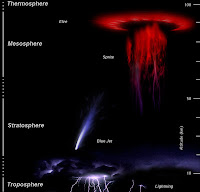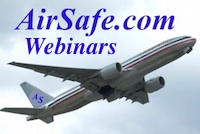The recent AirSafe.com interview featuring investigative journalist Leslie Kean has led at least one member of the audience to express concerns that the interview may attract unwanted attention from individuals who may seek to hurt my professional reputation, or the reputation of AirSafe.com, simply because my interview was in part about reports of UFOs and other unidentified aerial phenomena from pilots and high level military and government officials.
I thanked that person for his feedback, and assured him that those kinds of critics would likely have no effect on the work of AirSafe.com. My reasons were simple. My aviation work, both online and offline, has been focused on airline safety and security, with an emphasis on approaching issues from an analytical and engineering perspective. I sought out Leslie Kean because of the approach that she has taken, focusing on reliable witnesses and cases that were backed by official documentation.
I don't have an opinion as to what is behind reports of UFOs and unidentified aerial phenomena, but I do know that not everything is known about flying, particularly the subtleties of the behavior of the increasingly complex technologies used in aviation, or the behavior of the natural environment. I'm convinced that at least some of these eyewitness accounts are of natural phenomena that are either not well understood or completely novel.
The history of aviation is full of examples of phenomena that have the potential to affect safety, and where a thorough examination of the evidence may lead to changes.
Volcanic ash and upper atmospheric lightning are two examples that come to mind. Ash encounters can often have a rather massively negative effect on aircraft. It took several serious ash encounters and a general recognition of the potential for ash to cause havoc before the airline industry came up with a variety of approaches, including changes in operational procedures, that have had the effect of reducing the likelihood of a serious encounter. Pilots reported observations of upper-atmospheric electrical activity decades before scientists began to gain a much better understanding of their occurrences starting in the 1990s. While these events have so far not directly affected aircraft, they may be a factor to consider in the future in the design and operation of aircraft.In the interview with Leslie Kean, I discussed the 2006 O'Hare incident (where an unidentified craft was flying in close proximity to several passenger terminals) because of the security implications. In my view, any vehicle operating, or appearing to operate, in congested airspace around a major airport must be taken seriously. The fact that appeared to be a UFO should not matter to those responsible for controlling or securing the skies around airports.
More arguments for studying these events
As for any skeptics who may want to go on the attack, I think they would likely have a hard time putting up an effective argument with my point of view, which boils down to the following:
- Scientists, engineers, and aviators don't know everything about the natural environment or about aviation,
- No engineered system is perfect and can be improved,
- No security system or protocol is perfect and can be improved,
- Studying unusual events that are observed or experience in or near aircraft may enhance our knowledge of nature and technology, and reveal weaknesses in security systems or procedures, and
- Applying insights gained from studying these reports of unusual phenomena can reduce aviation risks through enhancements in technology, changes in operational procedures, and changes in security protocols.
My goal is to encourage my audience to consider having an open mind to all reports of events that appear to be either highly unusual or extremely improbable. Either such reports represent real but misunderstood phenomena, or they represent serious misinterpretations of well understood phenomena by aviation professionals. Either way, ignoring or discouraging such reports won't get the industry closer to understanding what is happening and what steps, if any, need to be taken to improve how aviation professionals are trained, how aircraft are built and operated, and how the airspace system is managed and regulated.
Resources from Leslie Kean
Research studies and links to reporting organizations
Leslie Kean's site ufosontherecord.com
Book - UFOs: Generals, Pilots, and Government Officials Go on the Record






 The AirSafe.com live webinar on how to become an on-air expert for radio or television was broadcast on June 6th. In that webinar, Dr. Todd Curtis of AirSafe.com, who has been a guest for dozens of radio and television shows over the past decade, explained how he became a sought after expert for media outlets like CNN, BBC, and Discovery Channel, and explained several of the basic steps you shold take if you aspire to get on the air.
The AirSafe.com live webinar on how to become an on-air expert for radio or television was broadcast on June 6th. In that webinar, Dr. Todd Curtis of AirSafe.com, who has been a guest for dozens of radio and television shows over the past decade, explained how he became a sought after expert for media outlets like CNN, BBC, and Discovery Channel, and explained several of the basic steps you shold take if you aspire to get on the air.









